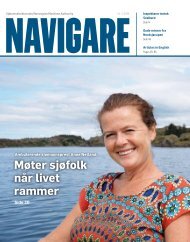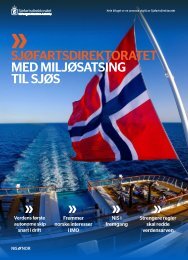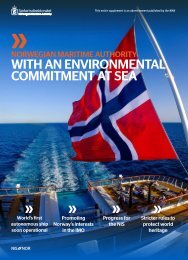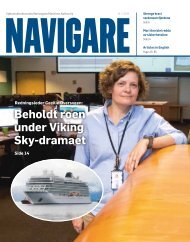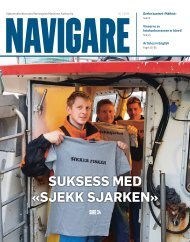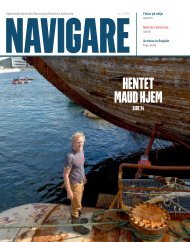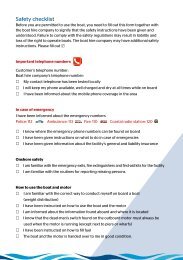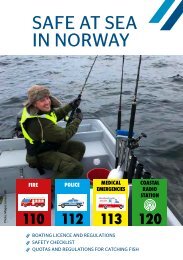Create successful ePaper yourself
Turn your PDF publications into a flip-book with our unique Google optimized e-Paper software.
EDITORIAL
ENGLISH TRANSLATION FROM PAGE 4
Constantly learning
At our main office in Haugesund, we
have four aluminium frames with
discoloured paper documents inside.
Even the aluminium shows distinct
signs of having been in the water. It
makes an impression to hold these
frames that one dark November night
went down in one of the worst
shipwrecks in Norwegian history.
On the 26th of November, it was 20
years since the high-speed craft
“Sleipner” hit the reef “Store Bloksen”
to the North of Haugesund. 16 people
lost their lives. A major rescue
operation contributed to the fact that
not more of the 85 people onboard lost
their lives in the cold and upset sea this
dark November day in 1999. The
question arose already that same night
– how could this happen?
After the accident, a maritime accident
inquiry was conducted. In addition to
the inquiry, a separate investigation
committee was established on 1
December 1999, only a few days after
the accident. The committee consisted
of six people and was headed by Arild
O. Eidesen. In their report, the
committee drew several conclusions, in
addition to making specific
recommendations to improve safety.
therefore been made – for instance
thermal life jackets and better training
and safety routines for crew members
onboard high-speed crafts. Our most
important job continues to be active
work to prevent such accidents from
ever happening. Many of the measures
are therefore connected to competence,
security management and electronic
aids – to mention a few.
Fortunately, there has been a steady
decrease in number of accidents, with
an improvement in the number of
personal injuries, and a significant
decrease in number of casualties. Over
the last ten years, there has only been a
small number of dead passengers
connected to shipping accidents in
Norway. However, the margins may be
narrow when it comes to the positive
outcome. We saw that only in March
this year, when the cruise ship «Viking
Sky» was close to running aground in
Hustadvika. This only shows that
safety work can never stop – we are
never finished.
Here, the shipping industry has a great
deal to learn from air traffic, which has
been extremely proficient when it
comes to putting things into a system
and establishing a good safety culture.
people ask for more focus on
responsibility, but we believe that the
focus that SHT has on causal relations
are the most important when it comes
to safety improvements. In addition,
the prosecuting authorities must of
course do its job if there is suspicion of
punishable offences.
The Sleipner accident reminds us that
it will always be at risk when carrying
passengers. Prior to the accident,
unfortunate misjudgements were made,
also by the Norwegian Maritime
Authority in certain areas. We would
like to offer our apologies to the
bereaved and to the survivors.
In the time after the accident, both the
Norwegian Maritime Authority and
others were challenged to work as fast
as possible on the recommendations
made. Big accidents often result in the
discovery of weaknesses of existing
regulations and routines, and
subsequently improvements are made.
After the Sleipner-shipwreck, several
changes to increase safety have
As regards safety work, it is also
important to mention the changes that
came about when we established a
separate marine department at the
Norwegian Accident Investigation
Board (AIBN). Den independent and
important role of the AIBN contributes
actively to strengthen safety through its
thorough investigations and
recommendations after accidents. Some
Lars Alvestad
Acting Director General of Shipping
and Navigation









